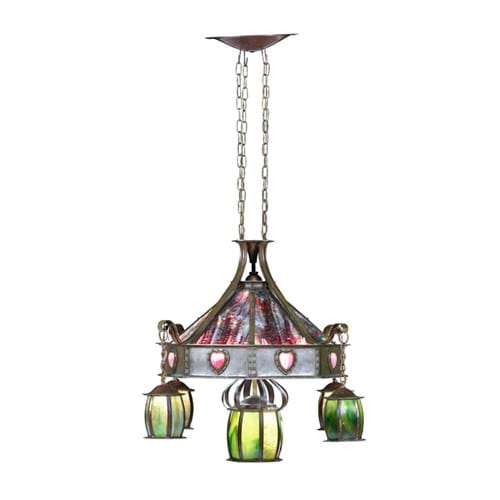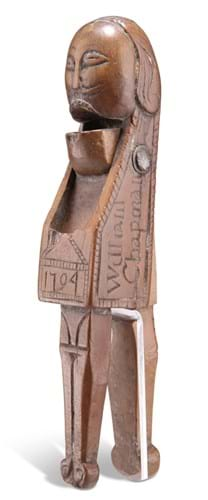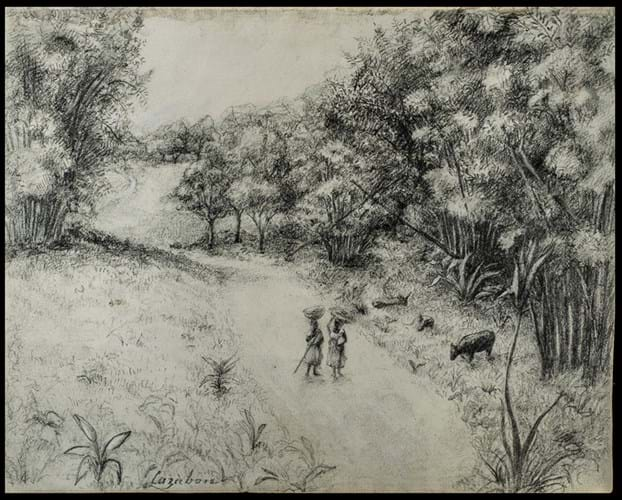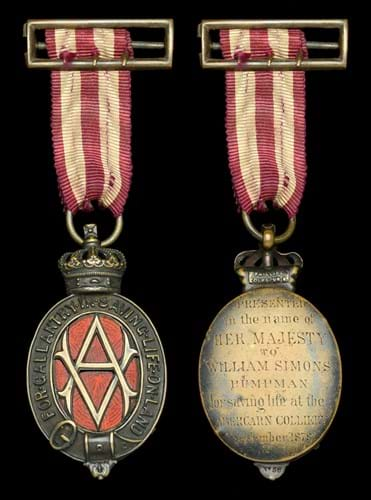1. Fruitwood nutcracker from 1706 – £6000
Screw-action nutcrackers, typically carved in boxwood or fruitwood, were popular throughout much of the 17th century, but were superseded at the end of the Stuart period by those based on the lever principle.
Many such as this rare example offered at Elstob & Elstob in Ripon on April 14, were carved as animals and figures. As with many of the most desirable treen works of art, this piece it is both named and dated – adding a sense of time and place to form and patination.
To the side is the name of the owner William Chapman (nutcrackers were often given as love tokens to mark an engagement or marriage) and to the front the date 1704.
Estimated at £1500-2000, it sold for £6000.
2. Trinidadian plantation drawing – £13,000
A drawing by Michel-Jean Cazabon (1813-88), Trinidad’s first internationally known artist, sold for £13,000 at Gerrards of Lytham St Annes on April 14. The estimate was £3000-5000.
The mixed-race son of immigrants from Martinique who owned a sugar plantation, Cazabon was schooled as an English gentleman at St Edmund’s College in Ware, and later at art school in Paris.
On his return to Trinidad in 1852 he is credited with introducing Europeans to the flora and fauna of the West Indies through plate books published the 1850s-60s.
George Harris, 3rd Baron Harris and governor of Trinidad from 1848-54, was a key patron. The collection of 44 Cazabon paintings displayed at his family seat, Belmont in Kent, is considered the key visual reference for 19th century Trinidad.
This 11 x 9in (27 x 17cm) graphite drawing highlighted with chalk depicts workers and livestock in a plantation.
It was consigned for sale after the auctioneers sold a watercolour by the artist in February 2020 for £24,000.
3. Arts & Crafts light fitting – £7200

Copper and glass Arts & Crafts light fitting by Harold Stabler and Richard Llewellyn Benson Rathbone – £7200 at Lyon & Turnbull.
This rare patinated copper and glass light fitting combines the talents of two Arts & Crafts luminaries: the designer Harold Stabler (1872-1945) and the maker Richard Llewellyn Benson Rathbone (1864-1939). It possibly dates from the period 1903-05 when both men were teaching at Liverpool University.
Benson Rathbone was a relative of WAS Benson and also the cousin of Harold Rathbone of Della Robbia pottery fame.
The light fitting had an estimate of £6000-8000 at the Design since 1860 sale at Lyon & Turnbull in Edinburgh on April 20-21 where it sold at £7200.
4. Steam ships on the Thames – £4500
Guided at £200-400, this late Victorian oil on canvas depicting steam ships on the Thames near Wapping sold for £4500 at Ramsay Cornish in Edinburgh on April 16. Inscribed to the back and signed E Fletcher, it is probably the work of the London marine painter Edward Henry Eugene Fletcher (1857-1945).
Relatively little is known his artistic life. The son of a Bengal boat pilot whose job was guiding shipping along the Hooghly River, he had first joined the Army Hospital Corp in Nov Scotia but had returned to London and to painting when invalided out in 1871. It appears he did not exhibit and instead made a living selling his pictures through dealers and galleries, sometimes using the pseudonym John Hayes for contractual reasons.
Today his work appears for sale with some regularity – admired for the subject matter (he almost exclusively painted views of the river Thames, its industry and its shipping) and his level of detail, the best of his pictures comparing favourably to those of William Wyllie.
5. Abercarn Colliery disaster medal – £4000
This Albert Medal Second Class for Gallantry in Saving Life on Land – sold by Dix Noonan & Webb in London on April 20 – was awarded to William Simons, for his heroics during the Abercarn Colliery disaster.
It tells a harrowing story. Shortly after midday on September 11, 1878, with 325 men and boys working underground, a large explosion had ripped through the Prince of Wales Colliery in Monmouth.
Known to his Welsh workmates as ‘Willie the Pump’, because he handled the huge water pump which kept the underground galleries from flooding, Simons had helped bring up around 80 survivors in the aftermath, many of them badly burnt. The Coroner’s Report recorded that “the pump-man never ceased from continuous labour for 12 or 14 hours after the explosion, although he, too, was surrounded by danger nearly every moment”.
Ultimately the disaster claimed 268 lives.
Made by the London jeweller Phillips of Cockspur Street in bronze and enamel, the reverse of the medal is engraved Presented in the name of Her Majesty to William Simons, Pumpman, for saving life at the Abercarn Colliery, September 1878. Estimated at £4000-5000, it took the low estimate of £4000.









